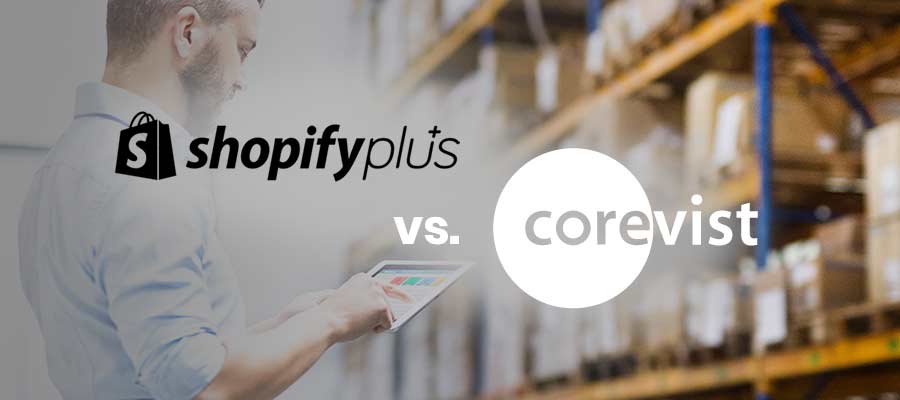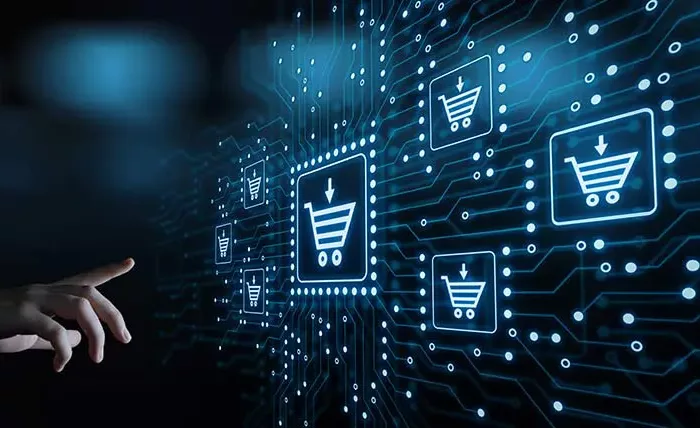Share
Author
George Anderson
Share
Shopify Plus Vs. Corevist
It’s not often that Corevist Commerce gets compared to Shopify Plus. Corevist is built for global manufacturers running SAP ERP, while Shopify Plus is built for retail brands.
That said, manufacturers sometimes come to us having used Shopify Plus in a complex B2B scenario—perhaps as a standalone proof-of-concept, perhaps as a permanent solution.
Either way, here’s what you need to know about Shopify Plus vs. Corevist. We’ll compare platforms in terms of these 5 questions:
- What features do Customers want to see?
- What features does the Business want to see?
- What features does Sales want to see?
- What features do Customer Service Reps want to see?
- What features does the IT team want to see?
1. What features do Customers want to see?
Real-time inventory availability
SHOPIFY: Customers need to know if a product is available—right now. Along with pricing and lead time estimates, availability one of the most important data points you can give your customers (or not) in ecommerce.
While Shopify can interact with SAP via middleware, it’s not clear whether middleware-based architecture can provide reliable, up-to-the-minute inventory availability in Shopify. For an outline of the problem, see this post: Direct Ecommerce Integration vs. Middleware.
COREVIST: Through our direct, real-time SAP integration, Corevist Commerce provides real-time inventory/ATP calculations out of the box. Whether you offer every customer the same inventory quantity, or use an ATP calculation to allocate product, Corevist supports the inventory display that’s built into your SAP system—including personalized ATP calculations straight from SAP.
Self-service invoice payments
SHOPIFY: As far as we know, Shopify Plus does not support this interaction with SAP.
COREVIST: We support self-service invoice viewing and payment, right out of the box. See our solutions for more information.
Mapping of user accounts to their parent organization
SHOPIFY: Shopify Plus only recognizes accounts at the individual user level, and not at the corporate account level. This means that an individual user may not be able to see the orders which another user at the same company has placed, even though they both work for the same customer.
COREVIST: Corevist supports the mapping of individual users to the overarching customer account. This means that all users who work for a customer account (and who have the appropriate permissions) can see all order history, order status, invoices, etc. associated with their employer’s account.
Note that Corevist also supports mapping of users to multiple ship-to/sold-to accounts, using relationships specified in SAP, for complex B2B scenarios. This functionality also allows us to map Sales reps to multiple customer accounts in our Field Sales Portal solution.
Clear communication about order lead times
SHOPIFY: We’ve heard manufacturers ask for a popup in Shopify notifying customers when they’ve placed orders past the fulfillment cutoff time for that business day. Without this kind of clarity, it may not be obvious to customers that their order won’t ship out that day.
COREVIST: Corevist solves this problem with SAP integration. Whatever RDD/EDD you currently have set up in SAP, Corevist supports that process in the ecommerce store and allows customers to choose an RDD or see their EDD.
2. What features does the Business want to see?
Removing credit card transaction fees
SHOPIFY: When it comes to transaction fees, Shopify has some of the highest on the market. The exact amount you’ll pay depends on whether you use Shopify Payments or a third party payment gateway.
COREVIST: We don’t charge transaction fees.
Better integration between Shopify, credit card processor, and SAP
SHOPIFY: We’ve heard of issues with middleware systems not making the connection between a Shopify, a credit card processor, and SAP. This may make it difficult for Accounting, Sales, or Marketing to know which system to turn to (Shopify or SAP) to know the “one true truth” about business data.
COREVIST: This is why Corevist is built on a direct, real-time integration to SAP ERP. Corevist acts a window into your SAP system, showing the appropriate SAP data in real time, with no delays or data duplication. For example, electronic payments in Corevist process through your credit card processor instantly, and are posted to SAP instantly, hands-free.
The ability to delete a user before they log in
SHOPIFY: Little things like this can cause irritation for busy teams: You cannot disable a user at any time in Shopify Plus; rather, you have to wait for them to login at least once. This is not ideal, especially if you sent an invite to a user by mistake.
COREVIST: Our solutions support user deletion at any time, regardless of whether the user has ever logged in.
Better mapping of the customer organization
SHOPIFY: We’ve covered this above in the Customer section, but it’s worth noting how it affects internal operations. Since Shopify Plus doesn’t support corporate accounts with multiple individual users, it’s difficult to get a view of a customer’s total history/activity with you.
COREVIST: Our solutions support multiple ship-to/sold-to, as well as multiple individual users associated with the same corporate account.
3. What features does Sales want to see?
A solution that’s built for on-behalf-of ordering, from any device
SHOPIFY: It’s unlikely that a manufacturer would choose to use Shopify Plus for a Field Sales Portal. Shopify Plus is intended for customers (and B2C customers, at that), and it doesn’t offer essential Field Sales Portal features like multiple customer assignments mapped from SAP, or the ability to order on behalf of those customers.
Cutting Sales out of the equation misses all kinds of opportunities for organizational synergy. If you’re transitioning an existing customer base to ecommerce, Sales is arguably your #1 ally in promoting ecommerce among customers.
That means you need Sales on board from the start.
COREVIST: You can get Sales on board, and pave the way for customer-facing ecommerce, by starting with the Corevist Field Sales Portal. The solution includes real-time mapping between the Sales rep’s account and his/her assigned customers–straight from SAP. It allows reps to order on behalf of any assigned customer, from any device, and gives reps full visibility into the account history of every customer they serve. You can roll this out to your reps first, then scale the solution to include Corevist Commerce for customers in Phase II (or beyond).
4. What features does Customer Service want to see?
Mapping of user accounts to their parent organization
SHOPIFY: Already mentioned twice above—but here’s how it impacts CSRs (customer service reps). When a customer calls in with an order problem (as they will, since there is no real-time SAP integration for accurate pricing, inventory, etc.), CSRs have no visibility into the entire account history for the company—only the order history for that individual.
COREVIST: We eliminate this problem by mapping your ecommerce users to high-level customer accounts.
Order updates from 3PLs populated automatically to SAP
SHOPIFY: Without a direct, real-time integration to SAP ERP, Shopify Plus creates the need for a manual workflow when you have a 3PL (3rd party logistics provider) fulfilling orders. Without that integration, a CSR will have to read order fulfillment updates in Shopify (performed by a 3PL employee) and manually change the order status in SAP.
Obviously, this workflow is fine at low order volumes. But it’s not scalable for manufacturers who plan to do hundreds of millions in revenue (or more) through ecommerce.
COREVIST: You can resolve this issue if you allow 3PL employees to access your Corevist solution. If you don’t want them to access the entire suite, we can limit their access to just the Order Tracking portion of the application. This allows them to update orders in SAP in real time without full access to SAP GUI.
See this post for more: B2B Ecommerce Access for 3PLs—Part 1.
5. What features does the IT team want to see?
A reliable, hands-free SAP integration that doesn’t need troubleshooting
SHOPIFY: In our experience, IT folks at manufacturers already have enough on their plates. They don’t need another bug to hunt down in a complex system.
Unfortunately, without a direct, real-time integration to SAP, Shopify Plus creates more work for IT. There will be order errors, manual updates to business rules in 3 places instead of 1 (Shopify, middleware, and SAP, as opposed to just SAP), and more.
COREVIST: Our solutions allow manufacturers to conduct ecommerce without IT pulling heroics. In fact, our real-time SAP integration allows 1/3 of our clients to run Corevist with no full-time staff dedicated to supporting our platform.
Moving forward: FREE case study
Want to see Corevist in real life? Download this case study on LORD Corporation. You’ll learn how this leading industrial manufacturer replaced an inadequate ecommerce solution with Corevist Commerce. LORD believed that if you could do something in SAP, that was where it should stay. Learn how Corevist delivered with SAP-integrated ecommerce.









